Petra is like a dreamy place on our planet. Its sandy rocks look like a city made of red roses, and the hot desert makes it unforgettable. In this guide, I’ll tell you everything you need to know before visiting Petra.
Visiting Petra was a dream come true for me. The moment I boarded the plane to Jordan, I couldn’t contain my excitement. With its majestic sandstone formations and rich history, Petra had always been a must-visit destination on my travel list.
Sure, it’s tempting to simply join the crowd and explore Petra. But trust me, there’s a whole world of wonder waiting to be discovered beyond the gates of this UNESCO World Heritage Site.
I’ve tried to cover almost every question you might have about this amazing place.
So, are you ready to start exploring?
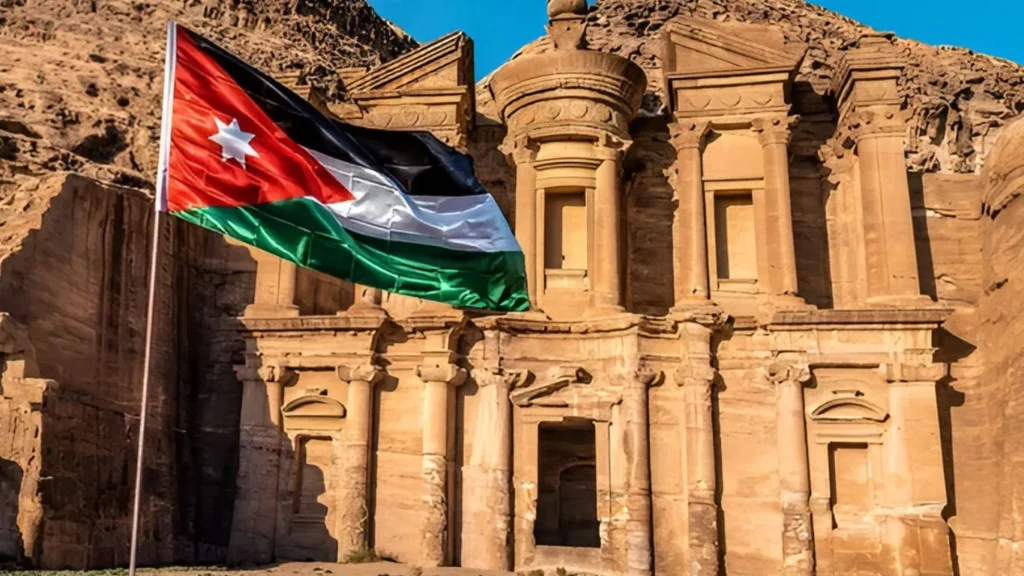
When Visiting Petra, Don’t Make These Mistakes
- Comfortable footwear: Petra involves a lot of walking, so wear sturdy, comfortable shoes to navigate the terrain comfortably.
- Hydration: The desert heat can be intense, so bring plenty of water to stay hydrated throughout your visit.
- Sun protection: Don’t forget to wear sunscreen, a hat, and sunglasses to shield yourself from the sun’s rays.
- Respectful attire: As a cultural site, dress modestly out of respect for local customs and traditions.
What Is Petra? Why is Petra Considered A Wonder Of The World?
Petra, nestled in the heart of Jordan, isn’t just any ancient city—it’s a marvel that leaves visitors in awe.
Imagine grand buildings intricately carved into towering cliffs of rose-colored sandstone, each facade telling stories of a civilization that thrived over 2,000 years ago.
This was the capital of the Nabatean Kingdom, a bustling hub of trade and culture that flourished from around 300 BCE to 106 CE.
Petra is considered a wonder of the world for numerous reasons what makes Petra truly extraordinary is its blend of architectural prowess and historical significance.
The Nabateans showcased their engineering brilliance by carving homes, temples, and tombs directly into the rock faces, creating a city that seamlessly merges with its natural surroundings.
These structures weren’t just places of dwelling—they were testaments to the Nabateans’ ingenuity and their mastery over stone.
Beyond its architectural splendor, Petra played a vital role in ancient trade routes, connecting the Arabian Peninsula with Egypt and the Mediterranean world.
Its strategic location made it a melting pot of cultures, where Nabateans, Greeks, Romans, and Arabs converged, exchanging goods, ideas, and beliefs.
But Petra isn’t just about ancient ruins—it’s also a breathtaking landscape of rugged canyons, towering cliffs, and desert vistas that captivate the senses.
Recognizing its universal value and cultural significance, Petra was designated as a UNESCO World Heritage Site in 1985 and later named one of the New7Wonders of the World in 2007.
These accolades underscore Petra’s status as a treasure of humanity, a place where history, culture, and natural beauty converge to create an unforgettable experience for all who visit which is why Petra is considered a wonder of the world!
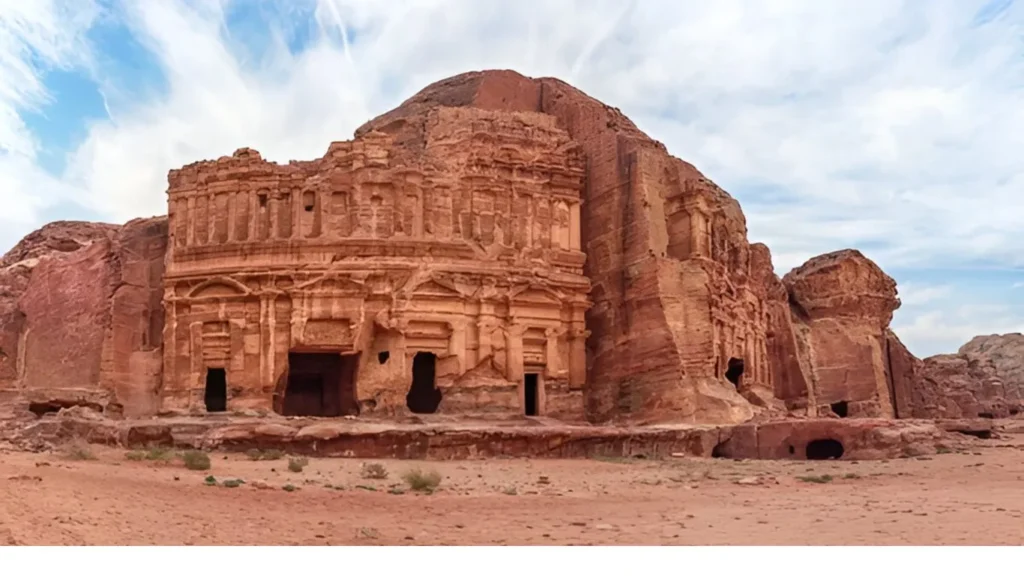
Is It Worth Visiting Petra?
Petra is truly a mesmerizing blend of ancient wonders and breathtaking scenery, making it a must-visit for history enthusiasts to cover historical destinations.
From the iconic Royal Tombs to the majestic Treasury and the towering Bab Al Siq, every corner of this legendary city offers something remarkable to explore.
The vibrant hues of the sandstone cliffs, bathed in the desert sun, create an unforgettable backdrop for your adventure.
Walking through Petra feels like stepping back in time, with each step revealing a new chapter of its rich history as it is known as the Jordan’s Lost City.
For me, Petra wasn’t just a trip—it was a journey to the heart of human civilization. Its beauty and historical significance left an everlasting impression on me, making it one of the most memorable places I’ve ever visited.
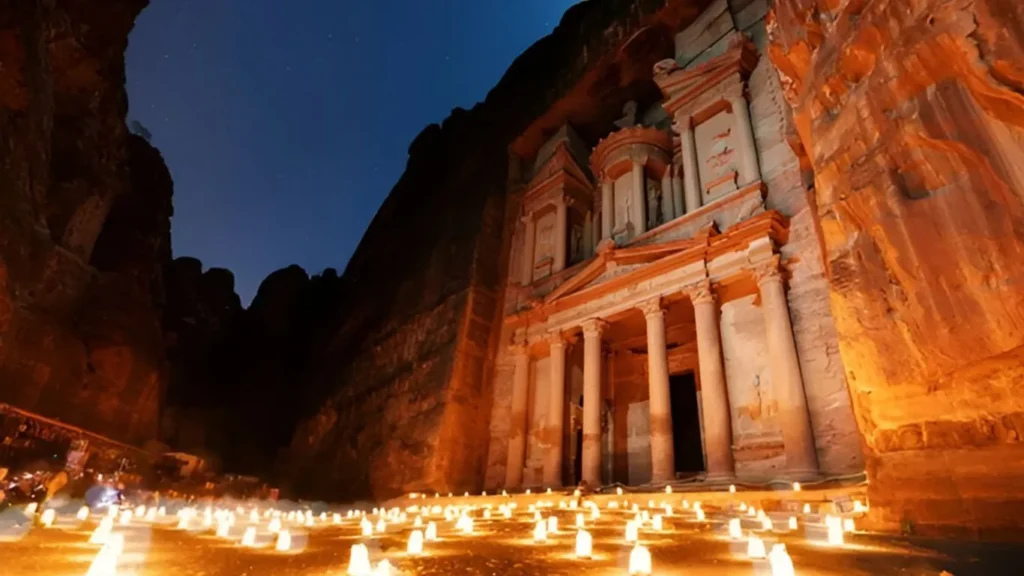
How To Reach Petra?
If you’re visiting Petra, reaching there is relatively straightforward, and there are several ways to get there depending on your starting point:
Flying: The closest major airport to Petra is Queen Alia International Airport (AMM) in Amman, Jordan. From there, you can either take a domestic flight to King Hussein International Airport in Aqaba or drive to Petra, which takes about three hours.
Driving: If you’re already in Jordan or traveling from neighboring countries, you can rent a car and drive to Petra. The drive from Amman to Petra takes around three to four hours, while the journey from Aqaba takes about two hours.
Public Transportation: There are also public buses that operate between major cities in Jordan, including Amman and Aqaba, with stops near Petra. However, be prepared for longer travel times and less frequent schedules compared to driving.
Once you arrive in the vicinity of Petra, you’ll need to purchase tickets and possibly arrange transportation to the entrance of the archaeological site, as it’s located a short distance from the town of Wadi Musa.
From there, you can explore Petra on foot or by hiring a local guide or horse-drawn carriage.
More on Dream Destinations
When Is The Best Time For Visiting Petra?
The best time for visiting Petra is during the spring (March to May) and autumn (September to November) months. During these seasons, the weather is mild and pleasant, making it ideal for exploring the archaeological site and hiking through the surrounding desert landscapes.
In spring, you’ll also have the opportunity to witness the desert bloom with colorful wildflowers, adding an extra layer of beauty to your visit. Additionally, the temperatures are not too hot during these months, allowing for comfortable sightseeing without the scorching heat of summer.
Avoid visiting Petra during the summer months (June to August) if possible, as temperatures can soar to extreme levels, making outdoor activities uncomfortable and potentially dangerous.
Winter (December to February) can also be chilly, especially in the evenings, although it’s still possible to visit Petra during this time if you come prepared with warm clothing.
Is It Safe Visiting Petra?
Yes, visiting Petra, Jordan, is generally considered safe for tourists. The area around Petra is well-policed and frequented by visitors from around the world.
How Much Is The Ticket Cost To Enter Petra?
The current ticket prices for visiting Petra are vary depending on the duration of your visit.
A one-day ticket costs around 50 Jordanian dinars (approximately $70 USD), while a two-day ticket is around 55 Jordanian dinars (approximately $77 USD).
There are also options for a three-day ticket and a Jordan Pass, which includes entry to multiple tourist sites in Jordan, including Petra.
Prices may vary, so it’s best to check the official Petra website here or inquire locally for the most up-to-date information.
What Are Petra’s Operational Timings?
Petra’s Visitor Center opens between 6:30 till 17:30 for visitors on a daily basis.
How Much Time Is Enough At Petra?
Spending a full day exploring Petra allows you to experience its grandeur and immerse yourself in its rich history.
However, to truly appreciate its beauty and discover its hidden gems, consider dedicating at least two days to Petra.
This extra time gives you the opportunity to explore the main attractions at a leisurely pace, venture off the beaten path, and soak in the magical atmosphere of this ancient wonder.
Trust me, every moment spent in Petra is a journey through time and a treasure to cherish forever.
Where To Have An Amazing Stay In Petra?
When staying in Petra, you have several accommodation options to choose from. The town of Wadi Musa, located near the entrance to Petra, offers a range of hotels, guesthouses, and hostels catering to different budgets.
Many visitors opt to stay in Wadi Musa due to its proximity to the archaeological site, making it convenient for exploring Petra, we had chose the same.
Additionally, there are several luxury resorts and Bedouin-style camps located in the surrounding desert area, offering unique and immersive accommodation experiences.
Whether you prefer a comfortable hotel stay or a more adventurous desert camping experience, there’s something for every traveler near Petra.
How Long Is The Walk Into Petra?
The walk into Petra from the Visitor Center spans a little over 2 kilometers and includes a walk through the Siq.
It typically takes about 30 minutes, possibly longer if you pause to snap some photos along the way.
How Long Does It Take To Get To The Monastery?
It typically takes around 45 minutes to 1 hour to hike from the main entrance of Petra to the Monastery, depending on your pace and fitness level.
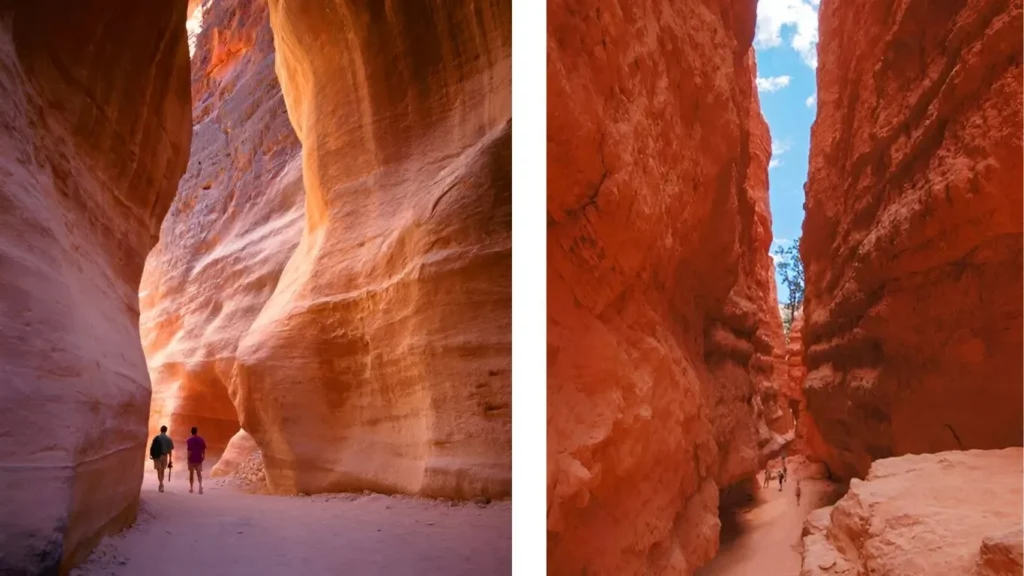
Can I Get Food And Drinks At Petra?
Yes, there are food and drink options available at Petra. Within the archaeological site, you’ll find several cafes and stalls where you can purchase snacks, drinks, and meals.
Additionally, there are restaurants and eateries located near the entrance of Petra in the town of Wadi Musa, offering a variety of dining options to suit your preferences.
Can You Go To Petra Alone?
Yes, visiting Petra on your own is absolutely safe.
The archaeological site is open to independent travelers, and you can explore it at your own pace.
Upon arrival at the visitor center, you can purchase tickets and enter Petra without the need for a guided tour.
However, if you prefer, guided tours are also available for those who want more information and context during their visit.
An Email You’ll LOVE!Join me to know more:)
What To Wear In Petra Jordan?
When preparing for visiting Petra, it’s essential to dress appropriately to ensure both comfort and respect for local customs.
Opt for lightweight, breathable clothing in light colors to stay cool under the desert sun.
I chose to have loose-fitting tops with sleeves that cover your shoulders, as well as pants or skirts that reach below the knee, are recommended to adhere to modesty standards and show respect for the local culture.
Choosing the right footwear is crucial for exploring Petra’s rocky terrain. Select sturdy, closed-toe shoes that provide support and protection from uneven surfaces.
Additionally, don’t forget to pack sun protection essentials such as a wide-brimmed hat, sunglasses, sunscreen, and a lightweight scarf or shawl to shield yourself from the sun’s rays.
As temperatures can fluctuate throughout the day, especially in the cooler months, it’s wise to dress in layers. Bring along a lightweight jacket or sweater that you can easily put on or take off when needed.
12 Best Things To Do In Petra – Jordan’s Lost City
1. Walk through the BAB AL Siq
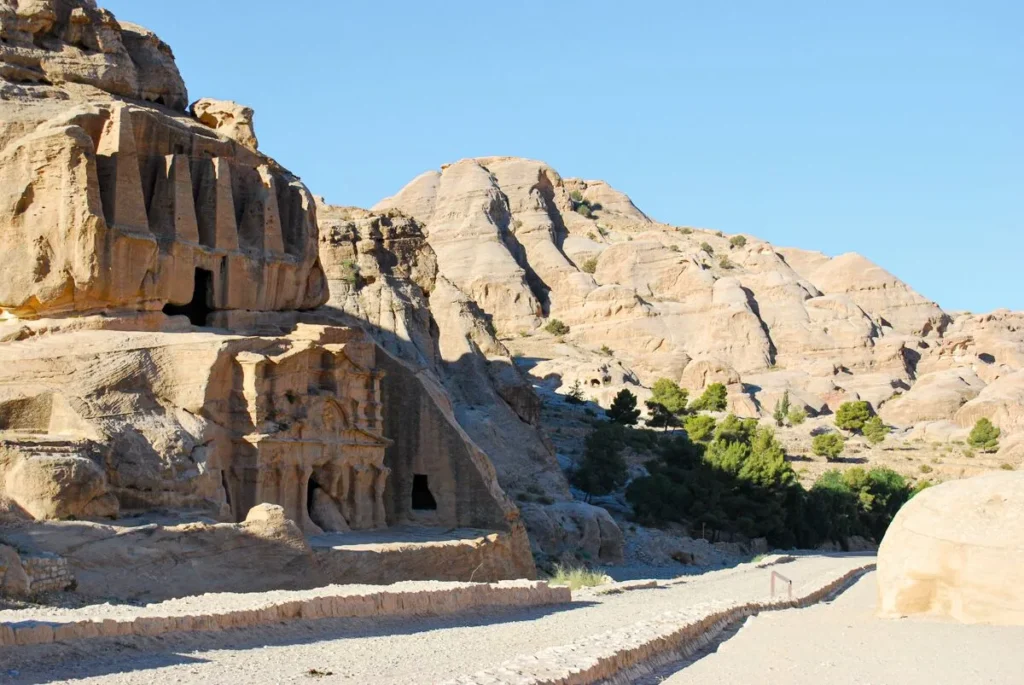
As you step into the Siq, you’ll be enveloped by towering cliffs that rise hundreds of feet above you, creating a natural canyon passageway unlike any other.
Admire the mesmerizing play of light and shadow as the sun filters through the narrow gorge, casting ever-changing patterns on the sandstone walls.
Keep an eye out for the intriguing rock formations and geological features that line the Siq, including ancient water channels carved into the rock by the Nabateans to channel water into the city.
Listen to the echoes of history as you walk in the footsteps of traders, pilgrims, and conquerors who traversed the Siq centuries ago, their voices still resonating in the very stone that surrounds you.
Be on the lookout for the remnants of Petra’s past that lie hidden along the Siq’s path, including carvings, inscriptions, and niches that offer glimpses into the city’s vibrant cultural and religious life.
2. Marvel at the Treasury (AL-KAZNEH)
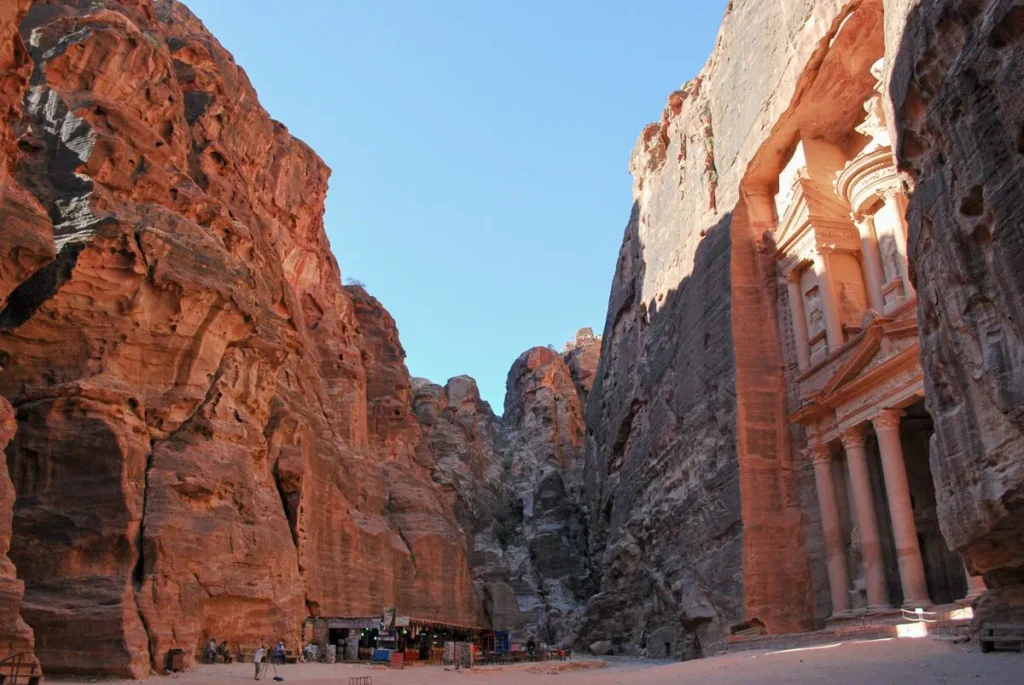
As you round the final bend of the Siq and catch your first glimpse of The Treasury, prepare to be spellbound by its sheer magnificence.
Standing over 40 meters tall, this iconic facade is adorned with intricate carvings and elaborate architectural details that showcase the skill and artistry of the Nabatean craftsmen.
Take a moment to admire the Treasury from different angles, allowing its beauty to unfold before you as you soak in the grandeur of its towering columns, ornate friezes, and sculpted figures.
Notice the subtle nuances of the Treasury’s design, from the delicate patterns etched into the sandstone to the hidden chambers and passageways that hint at the mysteries concealed within its walls.
Imagine the bustling activity that once filled the plaza in front of the Treasury, as traders, pilgrims, and dignitaries gathered to marvel at this architectural masterpiece and pay homage to the gods and goddesses worshipped by the Nabateans.
Capture the magic of the moment with your camera, but don’t forget to put it down and simply bask in the awe-inspiring presence of the Treasury.
3. Discover the Royal Tombs
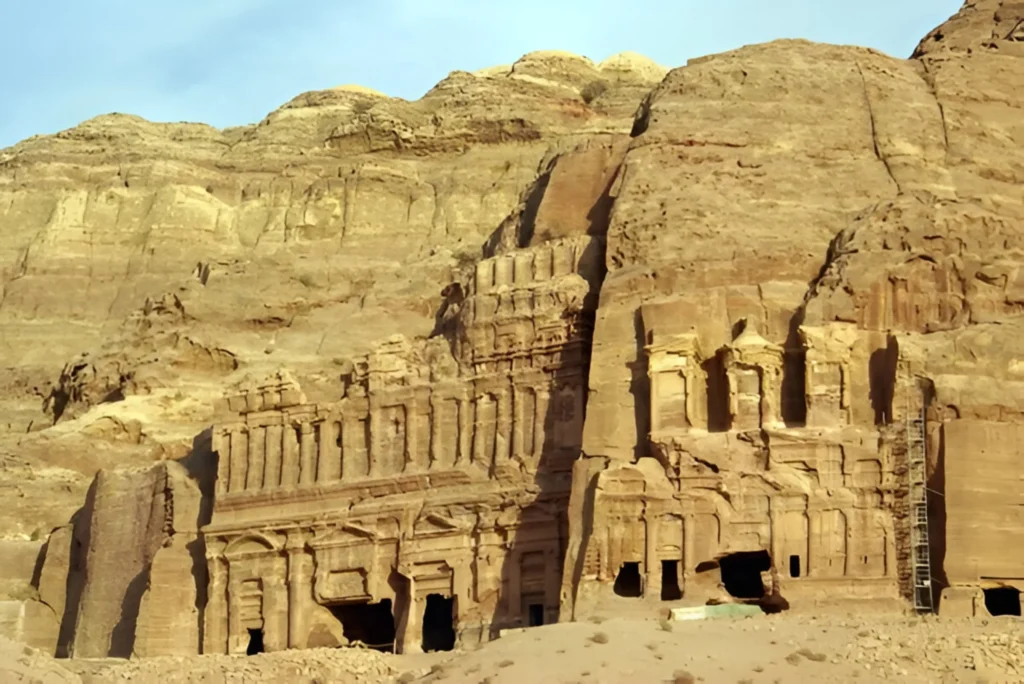
Step back in time as you wander among the majestic facades of Petra’s Royal Tombs, a collection of grand burial sites carved into the sandstone cliffs.
Each tomb is a testament to the wealth, power, and artistic sophistication of the Nabatean rulers who once called Petra home.
Marvel at the intricate architectural details and imposing scale of the Royal Tombs, which include notable structures such as the Urn Tomb, the Corinthian Tomb, and the Palace Tomb.
These monumental edifices are adorned with elaborate facades, decorative friezes, and towering columns that evoke a sense of majesty and grandeur.
Explore the interior chambers of the Royal Tombs, where you’ll find intricate carvings, painted frescoes, and ornate burial chambers that offer insight into the funerary practices and religious beliefs of the Nabateans.
4. Hike to the Monastery (Ad Deir)
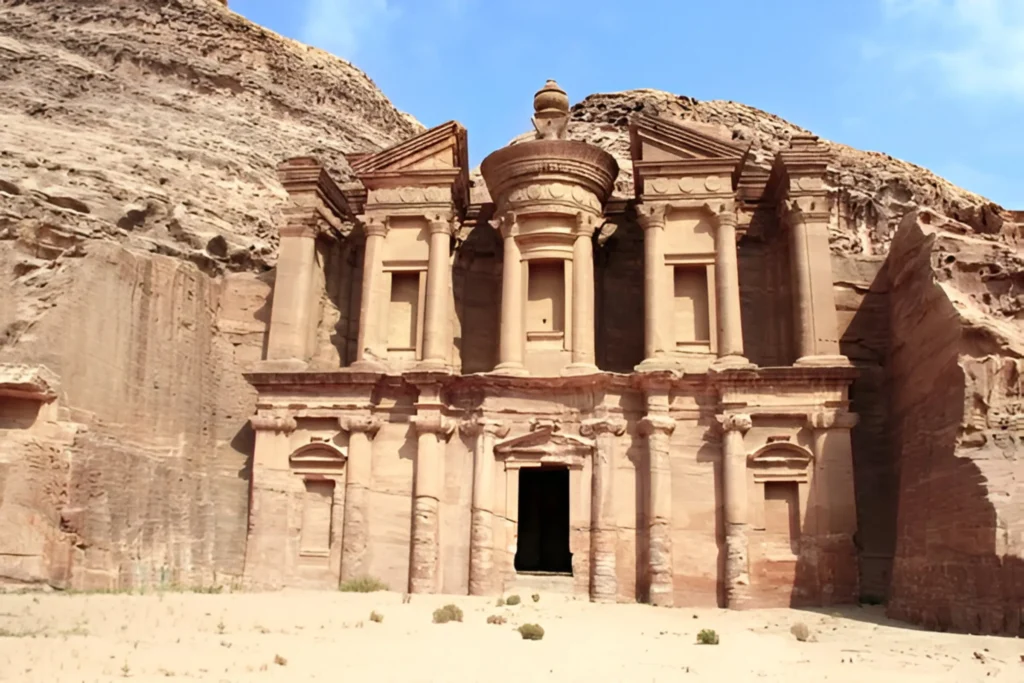
Located high atop a mountain ridge, the Monastery is a marvel of ancient architecture and a testament to the ingenuity of the Nabatean builders.
Begin your journey at the main entrance while visiting Petra and follow the well-marked trail that winds its way through rugged desert terrain and rocky cliffs.
Along the way, you’ll be treated to panoramic views of Petra’s majestic landscape, with its towering cliffs, deep ravines, and ancient ruins stretching out before you.
As you ascend the mountain, take your time to soak in the beauty of the surrounding scenery and marvel at the natural wonders that abound in this remote corner of the world. Keep an eye out for wildlife such as ibex, foxes, and birds of prey that call Petra home.
As you near the summit, prepare to be awe-struck by the sight of the Monastery looming in the distance, its massive facade towering over the landscape like a silent sentinel. Take a moment to catch your breath and admire the sheer scale and grandeur of this ancient monument.
Upon reaching the Monastery, pause to explore its intricately carved facade, which features elaborate architectural details and decorative motifs that showcase the artistic skill of the Nabatean craftsmen.
Step inside the cavernous interior and marvel at the vastness of the space, which once served as a place of worship and pilgrimage for the Nabateans.
5. Visit the Roman Theater
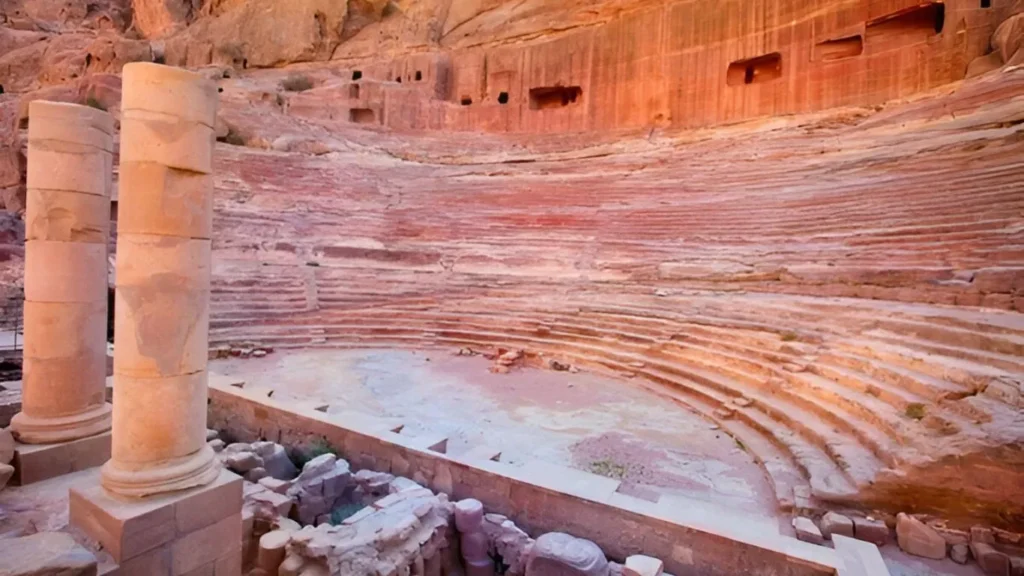
Transport yourself back in time to the days of the Roman Empire as you explore the well-preserved Roman Theater while visiting Petra.
Built during the 1st century AD by the Nabateans and later expanded by the Romans, this ancient amphitheater once served as the focal point of Petra’s social and cultural life.
Imagine the sights and sounds of ancient performances as you stand in the heart of the Roman Theater, surrounded by rows of stone seats that once accommodated thousands of spectators.
Picture actors, musicians, and orators taking to the stage to entertain and enlighten the crowds gathered below.
Climb to the top tiers of the Roman Theater for panoramic views of Petra’s ancient cityscape, including the Royal Tombs, the Treasury, and the rugged mountains that surround the site.
From this vantage point, you can actually appreciate the scale and grandeur of Petra’s architectural wonders and gain a deeper understanding of its historical significance.
You will fall in LOVE with the archaeological remains scattered around the Roman Theater, including ancient staircases, walkways, and underground chambers that offer insight into the theater’s construction and use over the centuries.
6. Explore the Street of Facades
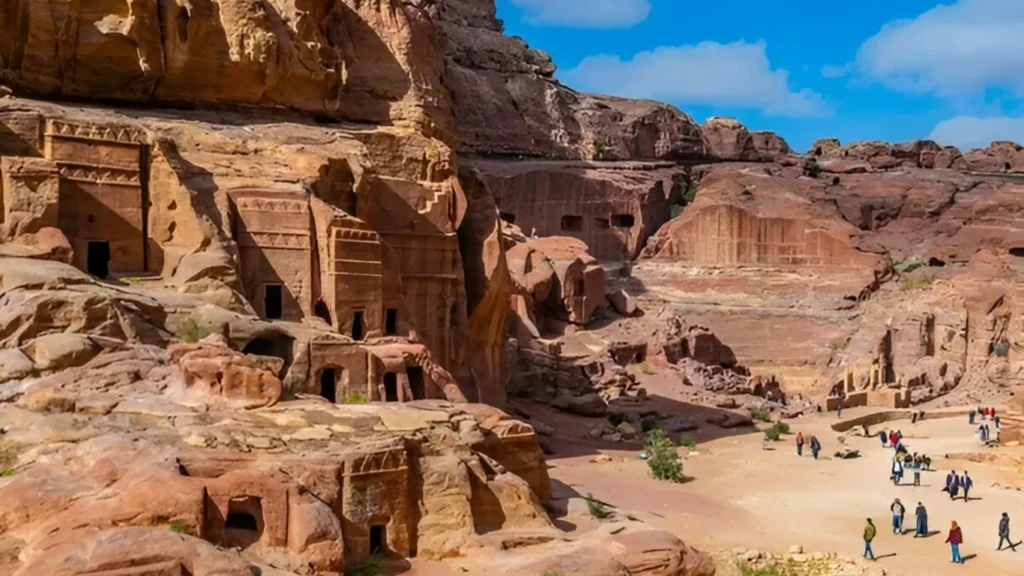
Embark on a journey through Petra’s ancient necropolis as you traverse the enchanting Street of Facades.
This atmospheric avenue is adorned with a stunning array of towering tombs and mausoleums, each bearing witness to the rich cultural tapestry of the Nabatean civilization.
Marvel at the exquisite craftsmanship and attention to detail evident in every sculpted column, archway, and frieze.
Delve into the stories etched into the stone as you explore the myriad tombs and burial chambers that flank the street.
Admire the symbolic motifs and religious iconography that adorn these ancient monuments, offering insights into the spiritual beliefs and funerary practices of the Nabateans.
7. Climb to the High Place of Sacrifice
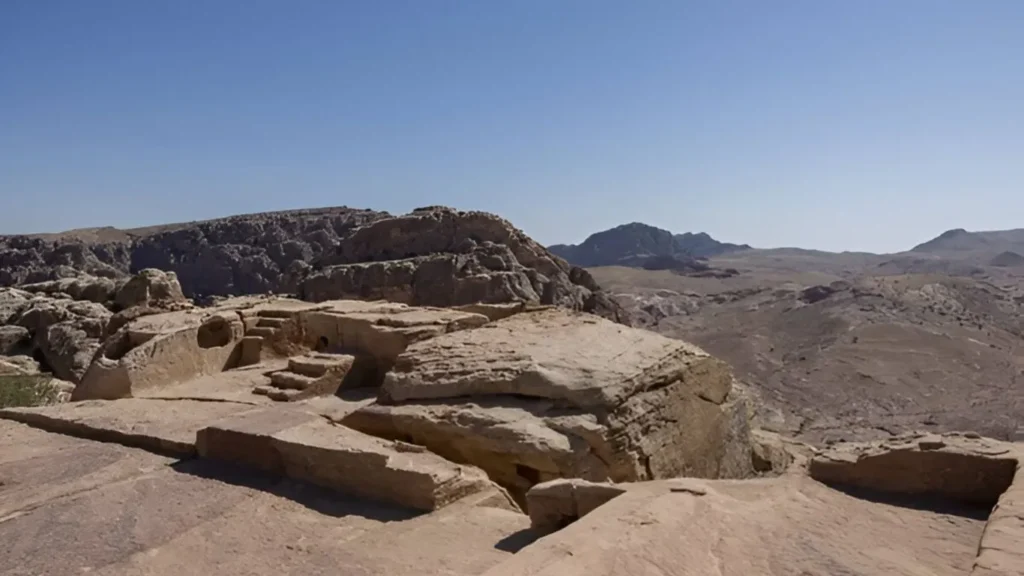
It will your breathtaking adventure as you ascend to the summit of Petra’s High Place of Sacrifice, a sacred site perched high above the ancient city.
Begin your journey at the foot of the mountain and follow the well-worn path that winds its way up the rocky slopes towards the High Place of Sacrifice. Along the way, marvel at the natural beauty of the surrounding landscape, with its rugged cliffs, winding canyons, and lush valleys.
As you ascend higher, pause to catch your breath and take in the stunning vistas that unfold before you, offering sweeping views of Petra’s iconic landmarks, including the Treasury, the Monastery, and the Royal Tombs.
Upon reaching the summit, prepare to be awestruck by the sight of the High Place of Sacrifice, with its towering altars, carved reliefs, and panoramic viewpoints.
Imagine the rituals and ceremonies that once took place in this sacred space, as priests and pilgrims gathered to offer sacrifices and prayers to the gods.
8. Admire the Great Temple
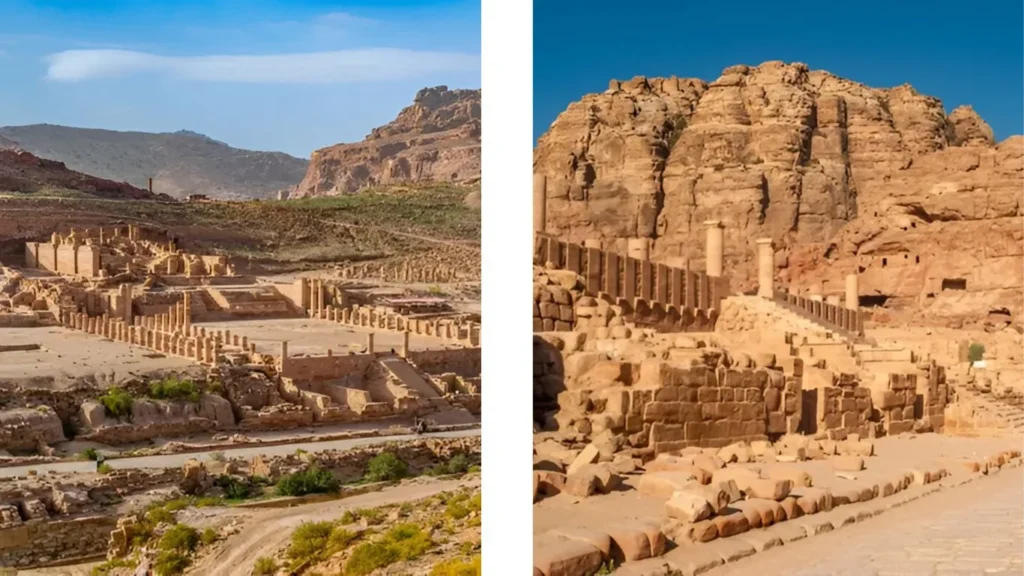
Prepare to be transported back in time as you explore the majestic ruins of Petra’s Great Temple, a monumental complex that once served as the religious as well as administrative center of the ancient city.
Begin your journey at the entrance to the Great Temple, where you’ll be greeted by towering columns, grand staircases, and imposing facades that hint at the scale and grandeur of this ancient complex.
Marvel at the engineering marvels that lie hidden beneath the surface of the Great Temple, including intricate water systems, underground chambers, and subterranean passages that once supplied the city with water and served as storage facilities.
Ascend to the temple’s highest points for panoramic views of Petra’s ancient cityscape, with its towering cliffs, rugged canyons, and sprawling ruins stretching out to the horizon.
From this vantage point, you can appreciate the strategic location and commanding presence of the Great Temple within the landscape of Petra.
9. Take a Camel Ride
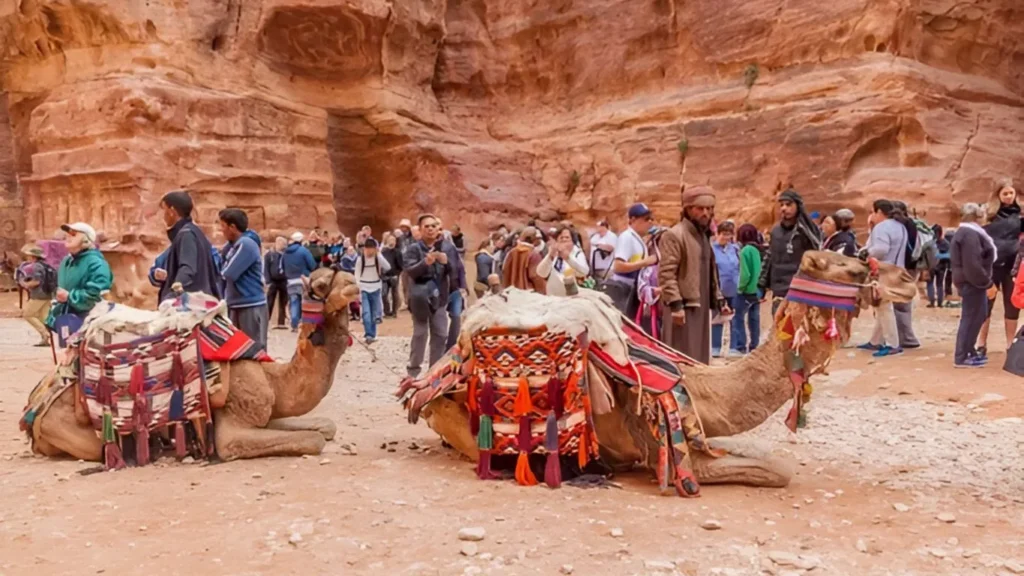
Embark on a memorable journey through Petra’s ancient landscapes with a camel ride, offering a unique and immersive way to experience the splendor of this historic site.
As you mount your trusty camel and set off on your adventure, you’ll feel a sense of connection to the desert nomads and traders who once traversed these same paths.
Begin your camel ride near the entrance to Petra, where you’ll be greeted by friendly guides and well-trained camels ready to accompany you on your journey.
Take a moment to familiarize yourself with your camel and settle into the comfortable saddle as you prepare for your desert adventure.
As you venture deeper into Petra’s rocky terrain, marvel at the stunning vistas that unfold before you, with towering cliffs, winding canyons, and ancient ruins stretching out to the horizon.
Feel the rhythm of the camel’s footsteps beneath you as you traverse the rugged landscape, gaining a newfound appreciation for the beauty and grandeur of Petra.
Pause along the way to capture the beauty of Petra’s iconic landmarks, including the Treasury, the Monastery, and the Royal Tombs, from unique vantage points that can only be reached by camel.
While visiting Petra, listen as your knowledgeable guide shares fascinating insights into the history, culture, and traditions of Petra, offering valuable context and perspective as you explore the site.
Learn about the ancient Nabateans who once called Petra home and discover the secrets of this UNESCO World Heritage Site.
10. Discover the Petra Museum
Learn more about Petra’s rich history and archaeological significance while visiting Petra at the Petra Museum, where artifacts and exhibits provide insight into the Nabatean civilization.
The Petra Museum is typically open from 8:00 AM to 6:00 PM daily, with slight variations depending on the season and local holidays.
11. Enjoy a Traditional Bedouin Meal
While visiting Petra don’t forget to indulge in a delicious meal of traditional Bedouin cuisine, served in a desert camp or local restaurant, and savor the flavors of Jordanian hospitality.
Popular Eateries To Enjoy The Traditional Bedouin Meal While Visiting Petra
The Cave Bar: Located near the entrance to Petra, The Cave Bar offers a unique dining experience in a cave-like setting, serving authentic Bedouin cuisine such as zarb (slow-cooked meat and vegetables) and mansaf (a traditional Jordanian dish of lamb cooked in fermented yogurt).
Petra Kitchen: This interactive cooking experience allows you to learn how to prepare traditional Bedouin dishes alongside local chefs. After cooking, you'll enjoy the fruits of your labor in a communal dining setting, feasting on a variety of Jordanian specialties.
Al-Wadi Restaurant: Situated within the Petra Guest House Hotel, Al-Wadi Restaurant offers a diverse menu of Jordanian and Middle Eastern dishes, including traditional Bedouin fare such as grilled meats, mezze platters, and freshly baked bread.
Beit Al-Barakah Restaurant: Nestled in the heart of Petra's ancient city, Beit Al-Barakah Restaurant serves authentic Bedouin cuisine in a charming setting with views of the surrounding mountains. Don't miss the opportunity to try their signature dishes, such as mansaf and maglouba (a savory rice dish with meat and vegetables).
12. Witness Petra by Night
Experience the magic of Petra illuminated by candlelight during the Petra by Night event, where the Treasury is bathed in a mystical glow, accompanied by traditional music and storytelling.
If time permits then you must explore the Byzantine Church while visiting Petra to delve into Petra’s Christian heritage an ancient place of worship adorned with well-preserved mosaic floors and intricate architectural details.
Take A Guided Tour For Visiting Petra
Gain deeper insights into Petra’s history, architecture, and significance by joining a guided tour led by knowledgeable local guides.
Explore hidden gems, learn fascinating stories, and uncover secrets of this ancient city during visiting Petra by your own with the help of knowledgeable guide.
Here You Have It An Ultimate Guide On Visiting Petra
Let me know when did you visited Petra in the comment below!
Would love to learn your experience even it can help me for my next trip to this beautiful land.
If you want to know something more about things to do in Petra or want to suggest something; Let’s connect in the comment section below:)
FAQs About Visiting Petra
Q.1 Can you go inside the Lost City of Petra?
Yes, travelers while visiting Petra can explore the ancient city of Petra by purchasing tickets and entering the archaeological site.
Q.2 What is one reason why Petra is referred to as the lost city?
Petra is often referred to as the “lost city” because it was abandoned and forgotten by the Western world for centuries, until its rediscovery in the early 19th century.
Q.3 How much of Petra is undiscovered?
A significant portion of Petra remains undiscovered and unexcavated, with estimates suggesting that only around 15% of the ancient city has been explored by archaeologists.
Q.4 What is unusual about Petra?
One unusual aspect of Petra is its architectural marvels, including structures carved directly into the sandstone cliffs, such as the Treasury and the Monastery, showcasing the ingenuity of the ancient Nabateans.
Q.5 Do I need cash in Petra?
It’s advisable to have cash on hand while visiting Petra for purchasing tickets, souvenirs, snacks, and other amenities, as not all vendors may accept credit cards.
Q.6 Do I need a guide in Petra?
While not mandatory, having a guide in Petra can enhance your experience by providing historical insights, navigating the site efficiently, and uncovering hidden gems.
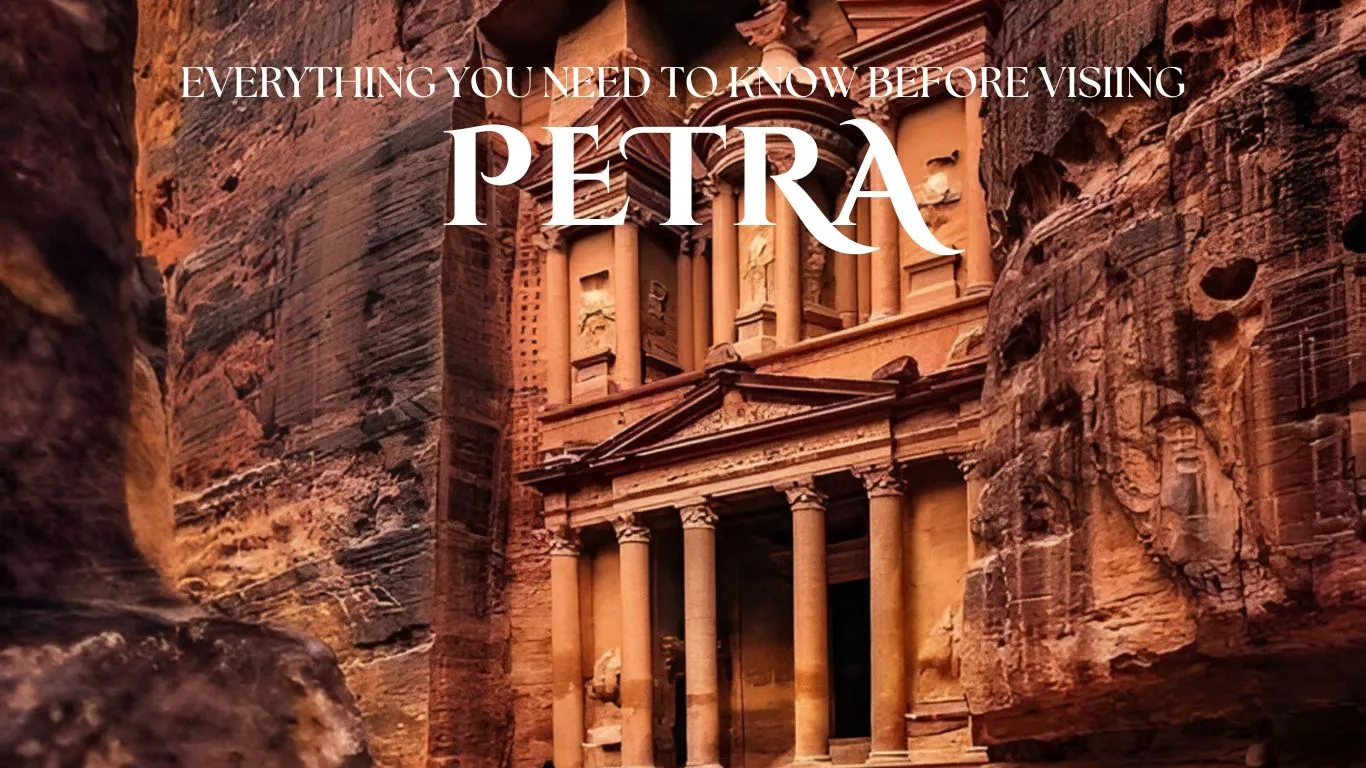
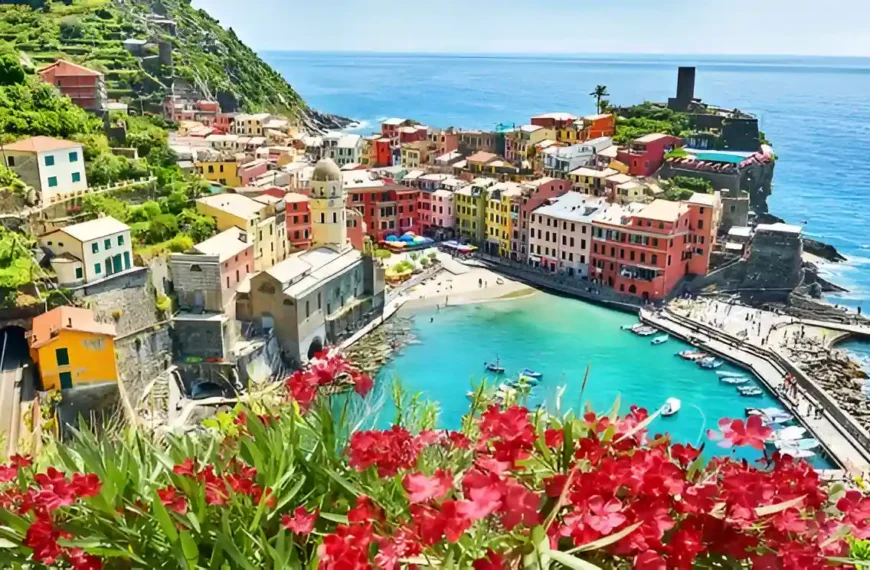
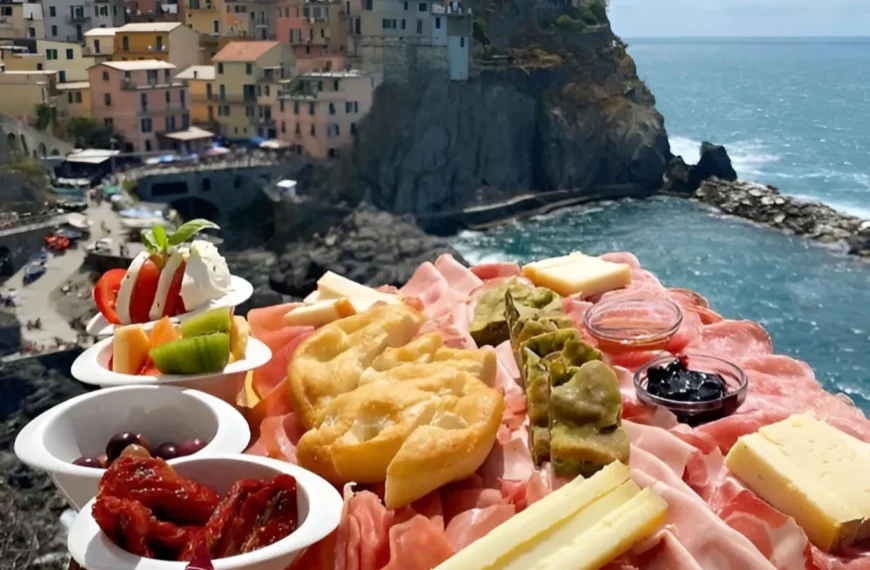


GOOD CONTAIN